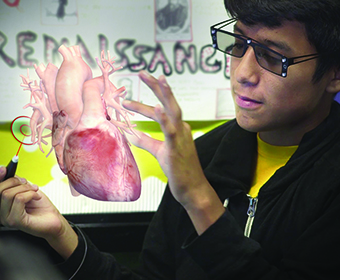
A student examines a heart in virtual reality. Photo credit: Eddie Hernandez
(March 13, 2019) -- To help shore up medical care in areas of the country known as “healthcare deserts” where minorities have little or no access to primary care doctors, The University of Texas at San Antonio (UTSA) will kick-off a virtual reality program in anatomy to prepare undergraduates pursuing careers in medicine.
“My hope is to give the next generation of physicians the competitive edge they require to succeed in rigorous professional schools and, more importantly, to help relieve the looming shortage of minority doctors,” said Eddie Hernandez, assistant professor in practice in the UTSA Department of Biology.
This week, a cohort of approximately 180 undergraduate juniors and seniors are taking course work in surgical anatomy and other medical topics through the Learning Enrichment in Medical and Surgical Anatomy (LEMSA) week-long seminar. The inaugural program incorporates virtual reality to help students better understand concepts in gross anatomy in preparation for medical or dental schools.
“VR is a perfect introduction to anatomy, as it allows the student to make mistakes often,” said Brett Chapa, a recent grad of UTSA currently applying to medical school and now serving as a collaborator of the program. “Mistakes are an essential part of education, and VR allows the student to explore the human body without compromising the structural integrity of those that donate their lives to science.
According to the Journal of the American Medical Association, universities around the world are using virtual reality to make medical education easier to grasp. The Taiwan Medical School has just announced that it will utilize one of the largest virtual reality anatomy labs in the world to teach its new incoming class. Even medical associations call for a better integration of technology with existing medical curriculum. Data from The Journal of the Missouri State Medical Association shows that students are more successful in anatomy courses when traditional laboratory instruction is combined with augmented reality.
UTSA’s spring break program will give students an opportunity to personalize their training by choosing exactly what they want to see. Participants can view each organ in 3D and virtually dissect structures to better understand the internal structures.
"Virtual reality allows students to take a very intimate look at the gross anatomy of the body,” said Hernandez.
The United States could see a shortage of up to 120,000 physicians by 2030, impacting patient care across the nation, according the Association of American Medical Colleges. That, coupled effect of a growing senior population that is estimated to grow by 50 percent in two decades and the retiring rate of doctors, could have the greatest impact on supply. Since it takes up to 10 years to train a doctor, the current shortage of medical professionals poses a real risk to patients.
UTSA undergraduates that enter into the pre-medical and pre-dental program has grown by 62 percent since 2008. The gross anatomy conference is March 11 – March 17 on the UTSA Main Campus.
Learn more about UTSA Premed and Predental programs.
Celebrate UTSA’s 50th Anniversary and share social media posts about the 50th using the hashtag #UTSA50.
Connect with UTSA online at Facebook, Twitter, YouTube, Instagram and LinkedIn.
UTSA Today is produced by University Communications and Marketing, the official news source of The University of Texas at San Antonio. Send your feedback to news@utsa.edu. Keep up-to-date on UTSA news by visiting UTSA Today. Connect with UTSA online at Facebook, Twitter, Youtube and Instagram.
Enjoy snacks while connecting with Adobe reps and student ambassadors. Download or log into the Adobe Express app to snag swag and unlock exclusive back-to-school templates. It’s a fun, fast way to get creative and start the school year with bold moves.
Central Plaza, Main CampusCelebrate the merger of UTSA and UT Health San Antonio with a pop-up featuring free t-shirts, exclusive swag, and interactive photo opportunities. Open to all students, faculty and staff. Supplies are limited!
Sombrilla Plaza, Main CampusHuddle Against Hunger is a fundraising competition with Texas State that benefits our Roadrunner Pantry. Donations this week will help UTSA earn additional prize monies provided by RBFCU.
In-Person and VirtualJoin UTSA Libraries for an update on federal public access policies and how the library can assist with compliance.
Virtual EventWe invite you to join us for Birds Up! Downtown, an exciting welcome back event designed to connect students with the different departments at the Downtown Campus. Students will have the opportunity to learn about some of the departments on campus, gain access to different resources, and collect some giveaways!
Bill Miller PlazaThere are many citation managers. Which one is right for you? This workshop will explain what a citation manager is and how it can help you organize your citations, insert citations as you write your paper, and generate your bibliography.
Virtual EventPubMed is an essential database for anyone conducting biomedical or health-related research. This workshop will teach attendees how to effectively navigate this free resource and locate peer-reviewed articles using advanced search features, MeSH subject headings, and Boolean operators.
Virtual EventThe University of Texas at San Antonio is dedicated to the advancement of knowledge through research and discovery, teaching and learning, community engagement and public service. As an institution of access and excellence, UTSA embraces multicultural traditions and serves as a center for intellectual and creative resources as well as a catalyst for socioeconomic development and the commercialization of intellectual property - for Texas, the nation and the world.
To be a premier public research university, providing access to educational excellence and preparing citizen leaders for the global environment.
We encourage an environment of dialogue and discovery, where integrity, excellence, respect, collaboration and innovation are fostered.